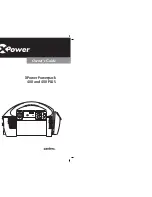
14
GCE 6-EC
Instructions for use
Before switching on the power tool
Unpack power tool and accessories and check that no parts
are missing or damaged.
Connecting the extractor (Figure B)
Connect extraction hose to the 32 mm connector.
Using a dust extraction system
Connect extraction hose to the dust extraction system.
Follow the operating instructions for the dust extraction sy-
stem! Check the attachment!
Attaching or changing the sanding tool
(Figure C)
Remove worn sanding tool from the Velcro pad.
Place the sanding sheet in the centre of the Velcro pad and
press on.
Conduct a test run to check that the sanding tool is clam-
ped in the centre.
Attaching/changing the sanding head
(Figure D, E)
To attach:
Press the two locks on the tool change head (
1.
).
Put the tool change head on the sanding head (
2.
).
Check that the locking mechanisms have returned to the
home position.
Switching the electric power tool on and off
(Figure F, G, H):
Push the switch rocker forwards and engage by pressing
the front end.
To switch off the power tool, release the switch rocker by
pressing the rear end.
Preselecting the speed (Figure I)
To set the operating speed, move the dial to the required value.
Working with the power tool
(Figure J)
1.
Attach sanding tool.
2.
Connect dust extraction system.
3.
Insert mains plug.
4.
Set required speed.
5.
Switch on dust extraction system.
6.
Hold the wall sander with both hands. This provides the
best possible combination of range and leverage for the
application.
7.
Switch on the device.
8.
Press the wall sander gently against the work surface
(the pressure should be just enough to ensure that the
sanding head is flush with the work surface).
9.
Increase the pressure to bring the sanding sheet into
contact with the work surface. In doing so, swing the
sander in overlapping movements to smooth the sur-
face to the required fineness.
Operating instructions
Brush ring
A brush-type ring surrounds the sanding head. This ring has
two functions:
–
As the ring projects above the surface of the sanding plate,
it is the ring which comes into contact with the work surface
first. As a result, the sanding head is brought parallel to the
work surface before the sanding tool comes into contact
with the work surface.
This avoids a sickle-shaped depression caused by the
edge of the sanding disc.
–
The ring also retains the dust until it is extracted by the dust
extractor.
If the brush ring is damaged or shows excessive wear, it should
be replaced (see section entitled “Maintenance and care”). Re-
placement brush rings are availa-ble from any FLEX customer
service centre.
Sanding in dry construction
When working, apply only as much pressure as is required to
keep the sanding plate in contact with the work surface. Exces-
sive pressure may result in a disagreeable spiral pattern of
scratches and an uneven work surface.
Move the sander constantly while the sanding plate is in con-
tact with the work surface. In doing so, ensure that you move
the sander evenly and over a wide area.
If you stop the sander on the work surface or move the sander
unevenly, this may result in a disagreeable spiral pattern of
scratches and an uneven work surface.
NOTE
The connection piece of the GCE 6-EC is a new development.If
electric power tools are used with conventional connection
pieces together with the extraction hose of the GCE 6-EC, an
adapter from the FLEX accessories programme can be used.
CAUTION!
–
When using the wall sander, connect a Class M dust
extractor.
–
If a dust bag is used which is not autho-rised for use with
dry construction dust, the amount of dust particles in the air
may increase at the work place. Over a prolonged period
high concentrations of dust in the air may damage the
human respiratory system.
Insert the special dust bag for dry construction dust into
your dust extractor according to the instructions supplied
with the dust extractor.
CAUTION!
Before performing any work on the electric power tool, pull out
the mains plug.
CAUTION!
Never use the Velcro pad as a sanding tool. Never use the wall
sander without the sanding sheet, otherwise the work surface
will be seriously damaged!
CAUTION!
Before performing any work on the electric power tool, pull out
the mains plug.
CAUTION!
Hold the electric power tool with both hands! When working, al-
ways have one hand on the handle – even when working with
attached extension. Keep your hands away from the sanding
head. Otherwise, your hand could become caught, as the san-
ding head swivels in different directions.
CAUTION!
The rotating parts of the sanding head must not come into
contact with sharp projecting objects (e.g. nails, screws, junc-
tion boxes). The Velcro pad may be damaged if it comes into
contact with projecting objects.
The Velcro pad can be replaced if it is damaged or severely
abraded (see section entitled “Maintenance and care”).
Содержание GCE 6-EC
Страница 1: ...GCE 6 EC ...
Страница 3: ...3 ...
Страница 4: ...4 ...
Страница 5: ...5 ...
Страница 130: ...502 278 07 2020 Für Druckfehler keine Gewähr Technische Änderungen vorbehalten ...















































